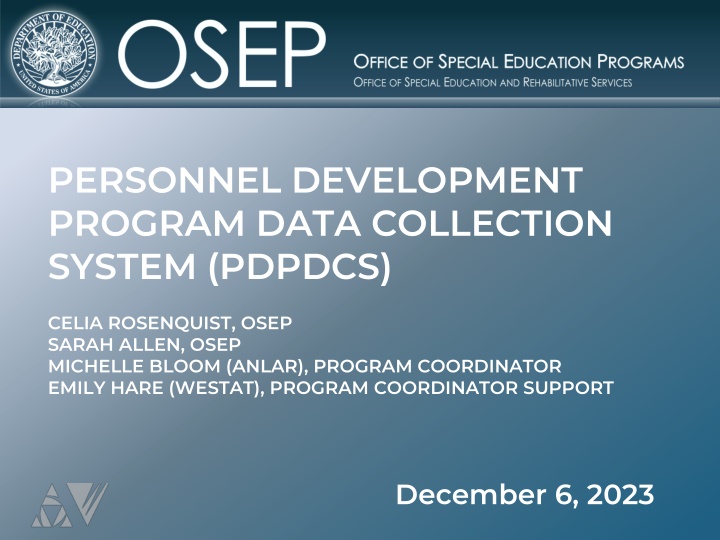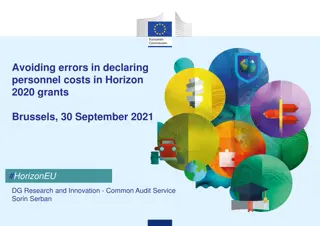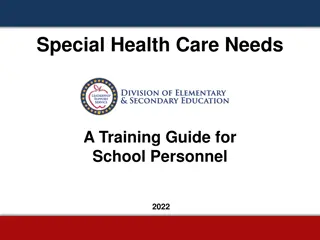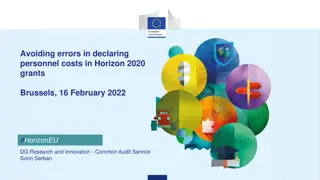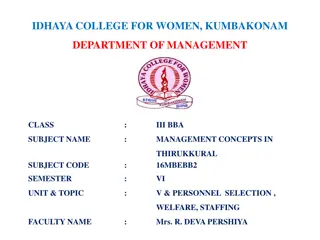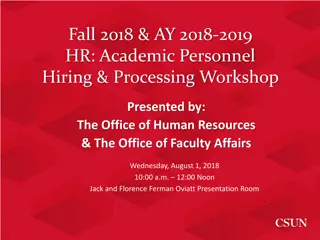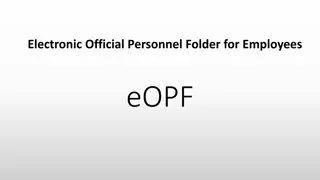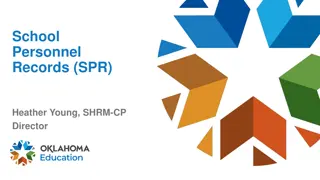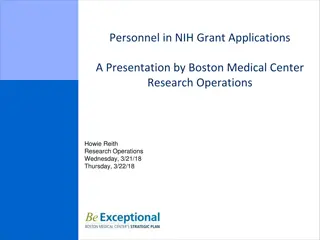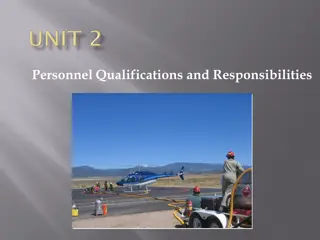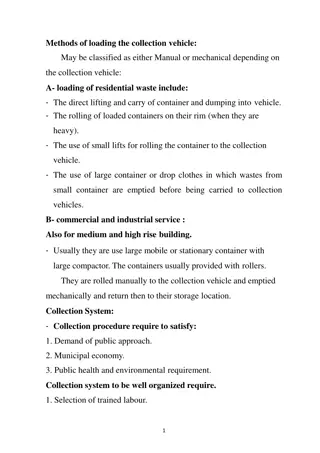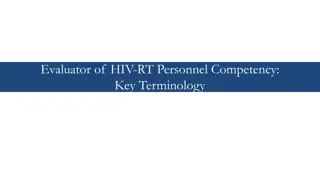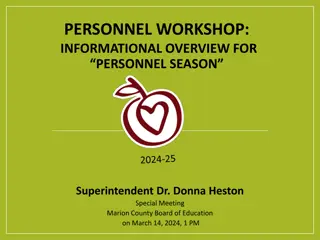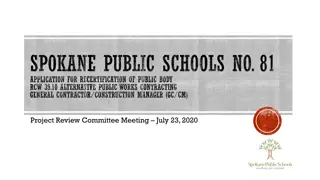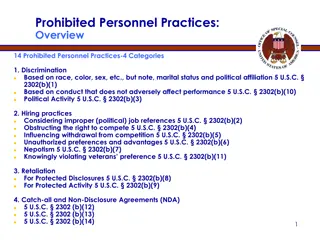Personnel Development Program Data Collection System Overview
The Personnel Development Program Data Collection System training aims to orient new grantees to data reporting requirements, improve data quality, and introduce the system. The training agenda includes grant priorities, reporting responsibilities, security strategies, and data submission processes. It covers grantee recruitment, regulatory compliance, scholarship assistance, scholar data updates, program exits, service obligations, repayment options, employment verification, and more. Specific grant priorities for FY 2023 include leadership personnel training for special education, early intervention, and related services, as well as preparation of personnel serving children with disabilities and related services personnel.
Download Presentation

Please find below an Image/Link to download the presentation.
The content on the website is provided AS IS for your information and personal use only. It may not be sold, licensed, or shared on other websites without obtaining consent from the author.If you encounter any issues during the download, it is possible that the publisher has removed the file from their server.
You are allowed to download the files provided on this website for personal or commercial use, subject to the condition that they are used lawfully. All files are the property of their respective owners.
The content on the website is provided AS IS for your information and personal use only. It may not be sold, licensed, or shared on other websites without obtaining consent from the author.
E N D
Presentation Transcript
PERSONNEL DEVELOPMENT PROGRAM DATA COLLECTION SYSTEM (PDPDCS) CELIA ROSENQUIST, OSEP SARAH ALLEN, OSEP MICHELLE BLOOM (ANLAR), PROGRAM COORDINATOR EMILY HARE (WESTAT), PROGRAM COORDINATOR SUPPORT December 6, 2023
Purpose of the Training Orient new grantees to data reporting requirements Improve the quality of data submitted by grantees Introduce the Personnel Development Program Data Collection System (PDPDCS) 2
Training Agenda 325D, 325K, 325M, and 325R grant priorities PDP grantee reporting requirements and performance measures PDPDCS demonstration Grantee reporting responsibilities for high quality data Strategies for avoiding security incidents Reminders for submitting PDP data Resources and supports 3
PDPDCS Data Submission Process OSEP Grantee recruits and selects scholars Grantee assures that scholars meet regulatory requirements before receiving federal funds awards grant Grantee provides scholarship assistance and grantee/scholar complete Pre- Scholarship Agreement Grantee submits and updates scholar data Scholar exits program and grantee/scholar complete Exit Certification Scholar fulfills obligation through service Scholar elects cash repayment or is not in compliance Scholar submits employment Scholar referred for cash repayment Employer verifies employment 4
GRANT PRIORITIES AND REQUIREMENTS
325D FY 2023 Priority Preparation of Special Education, Early Intervention, and Related Services Leadership Personnel Doctoral degree program to increased qualified personnel in leadership and research positions Prepares graduates for: Leadership positions as researchers Special education/early intervention/ related services personnel preparers in IHEs Leaders in SEAs, LAs, LEAs, or EIS programs 6
325K, 325R, & 325M FY 2023 Priorities 325K: Preparation of Early Intervention and Special Education Personnel Serving Children with Disabilities who have High-Intensity Needs 325R: Preparation of Related Services Personnel Serving Children with Disabilities who have High-Intensity Needs 325M: Personnel Preparation of Special Education, Early Intervention, and Related Services Personnel at Historically Black Colleges and Universities, Tribally Controlled Colleges and Universities, and other Minority Serving Institutions 7
325K, 325R, & 325M FY 2023 Priorities Degree programs to increased qualified personnel Certificate of completion not eligible Prepare scholars for professional practice in school settings, distance learning, and natural environments 8
Support for Service Obligation Consistent with 34 CFR 304.30, each scholar must Receive support for no less than one academic year, and b) Be eligible to fulfill service obligation requirements following degree program completion. Funding across degree programs may be applied differently. a) 9
Scholar Funding Funding does not need to be uniform for all enrolled scholars, but may include: Tuition and fees IHE student health insurance Books, materials, and supplies Misc. personal expenses Dependent or childcare Room and board Travel and conference registration Stipends to support scholars completion Do not require scholars to work (e.g., as graduate assistants) as a condition of receiving support 10
Scholar Recruitment Recruit and enroll the proposed number of scholars in the application within the first 12 months of the project Focus outreach on traditionally underrepresented applicants Prior approval from OSEP project officer required before admitting additional scholars beyond proposed number of scholars Submit a revised project budget if unable to recruit proposed number of scholars 11
GRANTEE REPORTING AND EVALUATION
PDP Performance Measures Purpose Helps measure whether the PDP is meeting its objectives Demonstrates PROGRAM progress and effectiveness over time Used by Congress to determine future program funding Required under the Government Performance and Results Act (GPRA) 13
PDP Government Performance and Results Act (GPRA) Measures Sources of Data: Grantee enters data in PDPDCS for each scholar receiving support on grant at - o Enrollment, o Annually during enrollment, and o Exit (e.g., complete degree program) Scholar enters employment information Employer(s) verify employment 14
PDP PROGRAM Performance Measure 1 The percentage of preparation programs that incorporate evidence-based practices into their curricula. Source of data: Expert panel review of syllabi from PDP grantees conducted one year following the grant award. Syllabi from FY 2022 grants will be reviewed & results reported in FY 2023 Syllabi submitted in application AND new or revised syllabi submitted to OSEP will be used More information will follow in Year 1 15
PDP PROGRAM Performance Measure 2 The percentage of scholars completing preparation programs who are knowledgeable and skilled in evidence-based practices for children with disabilities. Source of Data: Grantees enter data into the PDPDCS regarding scholar s exit/completion status and their chosen measure. Grantees must include at least one measure to demonstrate each scholar is knowledgeable and skilled in use of EBPs for children with disabilities. 16
PDP GPRA Performance Measure 2 - continued Examples of Measures of Knowledge and Skills ACCEPTABLE Measures UNACCEPTABLE Measures Grantee-specific tests (e.g., portfolio, comprehensive exam, dissertation defense) PRAXIS II National organization tests State-specific tests Capstone project or exam required of scholars prior to degree program or grant project completion Entrance exams (e.g., PRAXIS I, GRE, SAT) University preliminary exams Individual course exams or grades 17
PDP PROGRAM Performance Measure 3 The percentage of scholars who exit preparation program prior to completion due to poor academic performance. Source of data: Grantees report scholar s exit/completion status and reason for exiting prior to completion, if applicable. 18
PDP PROGRAM Performance Measure 4 The percentage of scholars completing preparation programs who are working in the area(s) for which they were prepared upon program completion. Sources of data: Grantees report scholar s training area and exit/completion status. Scholars and employers report scholar s employment area after exit. 19
PDP PROGRAM Performance Measure 5 The Federal cost per scholar who completed the preparation program. Sources of data: ED G5 database provides financial data for each grant; and Grantees report in G5 scholars funded under 84.325 grants who exited the training program through completion. 20
PDP PROGRAM Performance Measure 6 The percentage of scholars who completed the preparation program and are employed in high-need districts. Source of data: Scholars who have completed the preparation program and their employers have verified their employment. CCD and School Universe surveys determine if a district is labeled as high-need. 21
PDP PROGRAM Performance Measure 7 The percentage of scholars who completed the preparation program and are rated effective by their employers. Source of data: Scholars who have completed their program and choose to submit their employment information; and Employers rate the scholar s effectiveness during the verification process. 22
PDP PROGRAM Pilot Outcome Measure The percentage of scholars who completed the preparation program and are employed in the field of special education for at least two years. Source of data: Grantees report scholar s exit/completion status. Scholars and employers report scholar s employment area after exit. 23
Grant Performance Reports: APR Annual Performance Reports (APR) OSEP will send instructions for preparing and submitting APRs to grantees prior to February 1 annually APR Resources (https://osepideasthatwork.org/resources- grantees/program-areas/personnel-development-improve- services-and-results-children?tab=pa-measurement) Deadline for submitting is COB on the first Friday in May (4:30 pm ET) Submitted in G5 (http://www.g5.gov) 24
Grant Performance Reports: FPR Final Performance Report OSEP instructions will clarify which portions require updates, summaries of the full award period, and/or new information Due no later than 90 days after end of project award period Submitted in G5 25
FY 2023 Grants Project Evaluation Collect, analyze, and use data on scholars on an ongoing basis Continually evaluate the goals or objectives of the project Provide feedback and permit periodic assessment of progress toward achieving intended outcomes 26
PDPDCS: Live Demonstration PDPDCS demonstration will show: Logging into the system Updating grant and contact information Adding a secondary user Using the digital Pre-Scholarship Agreement (PSA) or uploading a physical PSA and entering scholar data Updating scholar data Tracking scholar s service obligation fulfillment Using the digital or physical Exit Agreement (EC) to exit a scholar 28
PDPDCS Setup Reminders: Secondary Users Project Directors are responsible for all data entries; however, secondary users are permitted to assist in the process. Secondary users: Can enter scholar information, and Have a unique log in. Only three people per grant may access. Project Directors may change the secondary user(s) at any time. Note:You may NOT create a shared inbox for your secondary user(s) each user requires a unique login. 29
Enrolling in MFA for the PDPDCS 1. Download and install Google Authenticator on your smartphone The app is available through the Apple App Store or Google Play Store by searching for Google Authenticator. 2. Pair the app and PDPDCS Open the Google Authenticator app Click the + button on the app to add the PDPDCS website Scan the QR Code from the PDPDCS website enroll page with your smartphone by holding the camera up to the website 30
Enrolling in MFA for the PDPDCS - continued 3. Enter code in the app Enter the code generated by the Google Authenticator app into the PDPDCS enroll page and click Validate. Remember to enter the code quickly as each code is only valid for 30 seconds. As soon as another code is generated, the preceding one becomes invalid. 6-digit code Enter code here 31
Signing into the PDPDCS in the Future Each time you sign into the PDPDCS from any device you will need to complete these steps: 1. Enter your username and password in the PDPDCS. 2. Open the Google Authenticator app on your smartphone and enter the 6-digit security code* into the PDPDCS when prompted by the system. Note: If you create a new password, you will need to scan the QR code on your smartphone again. If you purchase a new device, please contact the Help Desk to reset your MFA so you can scan the QR code and add it to your phone again. *Remember: Each code is only valid for 30 seconds 32
PDPDCS SUBMISSION REQUIREMENTS
PDPDCS Forms * Grantees and scholars must sign an OMB-approved Pre-Scholarship Agreement and Exit Certification for each funded scholar. * Grantees may be held responsible for funds provided to scholars with missing or invalid documents. * Grantees must retain all grant recordsuntil each scholar s service obligation has been fulfilled or paid back. 34
Timeline for Enrolling Scholars Enter and submit scholar contact and enrollment information within 30 days of scholar enrollment in degree program. The scholar must have: Registered for classes Received scholar support from grant project Signed PSA 35
Pending Scholars OSEP requires that scholars are in a pending status for no more than 30 days. Help Desk staff will contact you and your Project Officer if your grant has scholars in a pending status at the end of each annual data collection period. 36
Timeline for Updating and Exiting Scholars Update scholar contact and program completion information within 30 days of: Scholar status changes Enrolled but no longer funded Exited Prior to Completion Graduated Grant budget period ending Note: Scholars are not fully considered exited until the EC has been signed AND the scholar s record has been submitted. 37
Scholar Submission Requirements Once a scholar record is submitted by the grantee, scholars will access the PDPDCS to: Confirm contact information; Review training information; View service obligation status; and Enter eligible employment information to fulfill their service obligation. 38
Service Obligation Requirements Requirements for employment to be deemed eligible: Paid position, not funded by an OSEP grant program Cannot be part of an internship, practicum, or other work-related requirement of the scholar s completion of the preparation program 39
Service Obligation Requirements continued Direct Service: a. At least 51% of the infants, toddlers, and children to whom the individual provides services are receiving special education, related services, or early intervention services from the individual; or b. The individual spends at least 51% of their time providing special education, related services, or early intervention services to infants, toddlers, and children with disabilities. Indirect Service: a. If the position involves supervision including in the capacity of a principal, teaching at the postsecondary level, research, policy, technical assistance, program development, or administration, the individual spends at least 51% of their time performing work related to the scholarship training. 40
Scholars Employment Record Information collected includes: Contact information; Type of organization; Dates of employment; Type of employment; Full or part time position; Training area(s); Whether the position meets PDPDCS time requirements; and Certification or licensure. 41
Service Obligation Calculator Previous Employment Current Employment
Employer Submission Requirements Employers verify employment information within the PDPDCS Scholars do not receive credit for service obligation until the employer has verified their employment Scholars receive an email when their employment is verified or disputed 43
AVOIDING SECURITY INCIDENTS
Security Incidents A security incident occurs if personally identifiable information (PII) is potentially viewable to unrelated parties. Examples from PDPDCS: Uploading an unredacted Pre-Scholarship Agreement (PSA) PDF to the wrong scholar record Sending unencrypted documents (Social Security Card, Driver s License, etc.) in an email to the PDPDCS Help Desk 45
Impacts of Security Incidents on Department Staff PDPDCS staff must notify the Department s Education Security Operation Center (EDSOC), document the incident, and expunge the file or email from the servers Additional interviews, investigations, and mitigation strategies may be necessary PDPDCS Staff must review all other scholar records and documentation associated with the grantee 46
Impacts of Security Incidents on Grantees Grantees must resubmit scholar documentation, complete security incident report, and participate in investigation interviews as needed Project Directors and Secondary Users will be required to participate in a security training to understand the proper handling of scholar PII and the consequences of data breaches The grant will be placed on a security incident list tracked by PDPDCS and OSEP staff. If further incidents occur, the grant and university could be placed on high-risk status, impacting their ability to receive future federal funding 47
Avoiding Security Incidents Always encrypt files being sent by email, including to the PDPDCS Help Desk. Use the digital Pre-Scholarship Agreements and Exit Certifications to avoid uploading a document to the wrong scholar record. Implement a file naming convention to track files associated with each scholar s record: PSA_J_DOE.pdf. 48
HELPFUL PDPDCS REMINDERS
Always Read System Emails Notifications regarding system or policy changes as well as data submission reminders are sent via email. Please add serviceobligation@ed.gov to your contact list. Check your email settings to be sure emails from this account are not marked as spam. 50
